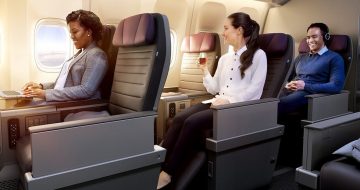
Hong Kong’s economy has been hit by six months of civil unrest, with the city entering a recession in the third quarter and its airlines among the companies that have suffered.
Flag carrier Cathay Pacific saw its China traffic plummet by nearly 22 per cent as mainland travellers balked at visiting the protest-hit city, while Hong Kong Airlines is planning to cease service to the United States and “continue to adjust” other routes.
Airlines based outside Hong Kong that fly into the city have also been adjusting their frequencies. Last week, South African Airways suspended its Hong Kong route, while some Chinese airlines have aggressively cut capacity on routes to Hong Kong, according to Reuters.
Despite the difficult time for the city’s airlines, the director general of industry trade body the Association of Asia Pacific Airlines (AAPA) firmly believes that Hong Kong’s aviation sector will recover.
“I’ve every confidence that Hong Kong will recover and be strong again, but in the short term [there’s a] level of uncertainty about the situation there,” said Andrew Herdman in a phone interview with Business Traveller Asia-Pacific.
He added: “Overall, there’s a lot of good will towards Hong Kong and interest in Hong Kong and I’ve no doubt that calm will be restored, and inbound demand will recover. Right now [though], it’s very weak.
“There’s been a significant impact on inbound tourists to Hong Kong – 30 to 40 per cent down. Obviously, airlines have responded by temporarily cutting capacity. As and when that picks up, airlines will quickly establish additional services as demand picks up.”
Herdman said that airlines like Cathay Pacific and Hong Kong Airlines have been the hardest hit, while airlines based outside of Hong Kong will be able to adapt to the decrease in demand more easily.
“For the airlines not based in Hong Kong, it’s just one of many in their route networks and they can adjust fairly easily. The key thing is the airport is operating normally, airlines are operating normally, operationally things are running smoothly – but it’s understandable that demand is affected by what people see on television. You’ve always had this disconnect about what you’re seeing on television and what you actually experience in Hong Kong,” Herdman said.
In August, protestors occupied Hong Kong International Airport, but the airport authority was quickly able to obtain an injunction limiting protestors’ access to the airport.
As Business Traveller Asia-Pacific reported earlier this month, Cathay Pacific saw 5.4 per cent growth in European traffic in October compared with the same month in 2018, despite the ongoing civil unrest. All other regions (besides the Southwest Pacific, which saw 1.4 per cent growth) saw demand weaken, however. Mainland China was by far the worst hit, with a 21.9 per cent drop in demand.
Asked to explain the increase in European demand, Herdman said: “It’s mostly transit traffic, and you just need to be able to convince people that the airport is operating smoothly. Hong Kong is one of the world’s most successful aviation hubs, and some months back when the airport itself was disrupted for two or three days obviously that would have affected confidence in Hong Kong as a hub – but that was only for two to three days. I’d emphasise the fact that when you’re entering, leaving or transiting through Hong Kong, the airport is running smoothly.”












